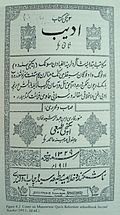|
Southern Uzbek language
Southern Uzbek, also known as Afghan Uzbek, is the southern variant of the Uzbek language, spoken chiefly in Afghanistan with up to 4.6 million speakers including first and second language speakers.[1] It uses the Perso-Arabic writing system in contrast to the language variant of Uzbekistan. Southern Uzbek is intelligible with the Northern Uzbek spoken in Uzbekistan to a certain degree. However, it has differences in grammar and also many more loan words from Dari, the local New Persian variety, in which many Southern Uzbek speakers are proficient.[3] Southern Uzbek Alphabet Southern Uzbek is written using the Perso-Arabic writing system called Arab Yozuv عرب یازوو ("Arab Script"). The writing system is for the most part identical to Persian alphabet, with 3 additional letters. These include two vowels, "اۉ / ۉ" and "اې / ې" (optional in writing, and substitutable in practice by "او / و" and "ای / ی" respectively), which are meant to represent the sounds represented in Uzbek Latin Script with "E e" and "Oʻ oʻ". The alphabet also includes a combined consonant letter "نگ", formerly (and currently in writing systems such as Uyghur) shown with the letter "ڭ". This letter represents the sound /ŋ/, and represented in the Latin writing system with "-ng". This letter makes the Voiced velar nasal sound, where in English one can for example hear when pronouncing the word "wingman". Uzbek has 6 vowels, and it has lost its vowel harmony rules, unlike other Turkic languages.[4]
Other than the additional combined letter "نگ / -ng", the consonants of Uzbek Arabic Alphabet are identical to that of Persian. Thus, there indeed is a case of various letters representing the same sound, as is the case in Persian. But the letters "ث، ح، ذ، ژ، ص، ض، ط، ظ، ع" are not used for writing of native Uzbek words. They are solely used for writing of loanwords from Arabic, Persian, or any of the European languages.
See alsoReferences
External linksDictionaries
|
|||||||||||||||||||||||||||||||||||||||||||||||||||||||||||||||||||||||||||||||||||||||||||||||||||||||||||||||||||||||||||||||||||||||||||||||||||||||||||||||||||||||||||||||||||||||||||||||||||||||||||||||||||||||||||||||||||||||||||||||||||||||||||||||||||||||||||||||||||||||||||||||||||||||||||||||||||||||

